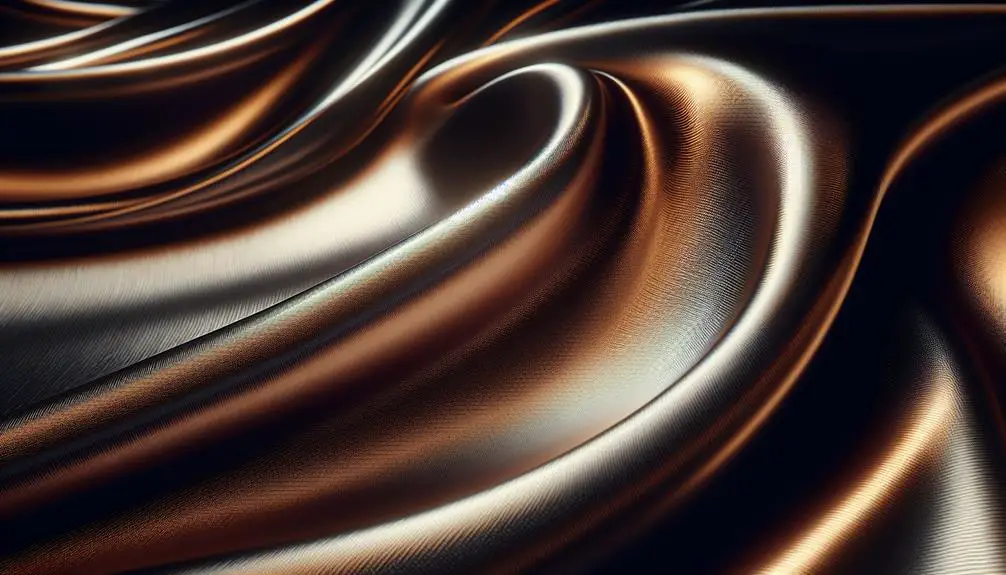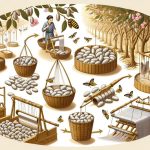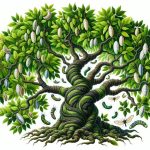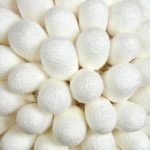I'd describe silk as luxurious, with a smooth texture and glossy sheen, all from silkworm cocoons. It's a fabric rich in history and highly coveted. The process behind silk is intricate, involving mulberry trees and a special production method. From chiffon to satin, silk comes in various forms for fashion and decor. While silk is known for its beauty, there are ethical concerns about silkworms' treatment. If you want to uncover more about silk's production, characteristics, and variants, keep exploring the fascinating world of this precious fabric.
Table of Contents
Key Takeaways
- Smooth, lustrous fabric derived from silk moth cocoons.
- Mulberry silk, a luxury variant known for its soft, satiny texture.
- Silkworm cocoons are vital in silk production, transformed into glossy, sophisticated fabric.
- Silk variants like chiffon, crêpe de Chine, and satin offer unique textures and finishes.
- Concerns about animal rights in silk production led to the development of alternatives like peace silk.
Characteristics of Silk
Silk feels luxuriously smooth against the skin, making it a highly coveted fabric for a range of products. This lustrous fiber comes from the silk industry's intricate production process, often intertwined with the rich history of silk trade. The silk trade has been historically significant, with silk production originating in regions like China, where mulberry trees are cultivated to feed the silkworms responsible for spinning the silk threads.
The luxury associated with silk stems not only from its exquisite feel but also from its glossy sheen that adds an elegant touch to any item it adorns. This fabric, known for its resemblance to cashmere in softness, is a staple in high-end clothing, fancy curtains, and opulent upholstery. The allure of silk lies in its ability to blur the lines between decor and fashion, making it a sought-after material for those who appreciate the finer things in life.
Silks Physical Properties
Smooth and lustrous, silk's physical properties captivate with their luxurious allure, enticing both touch and sight. Silk fibers, derived from the cocoon of the silk moth, create a fabric renowned for its glossy sheen and unparalleled softness. Mulberry silk, a type of silk cloth made from silkworms fed exclusively on mulberry leaves, is considered a luxury good due to its exceptional quality and feel. This exquisite fabric blurs the boundaries between everyday use and opulence, finding its place in high-end clothing, elegant draperies, and sophisticated upholstery. Its soft, satiny texture and glossy sheen make it a sought-after material in both the fashion and interior decor industries, adding a touch of sophistication to any product it graces.
| Property | Description |
|---|---|
| Softness | Comparable to cashmere |
| Glossy Sheen | Luxurious and elegant |
| Versatility | Used in various products |
Silks Production Process
As we explore the intricate world of silk production, a fascinating process unfolds involving the care of silkworms and the delicate extraction of their precious fibers.
- Silkworm Cocoons: Silkworms spin cocoons made of silk fibers to protect themselves during the pupal stage.
- Mulberry Silkworm: The most common type used in silk production, these silkworms feed on mulberry leaves, creating fine silk fibers.
- Silk Reeling: After the cocoons are collected, they're soaked in hot water to soften the sericin (silk protein) and then unraveled to obtain long silk fibers.
- Wild Silk: Silk produced by wild silkworms, like the Tasar silkworm, presents unique challenges due to the different properties of the silk and its resistance to dyeing.
Understanding the production process highlights the intricate care and attention required to transform silkworm cocoons into the luxurious silk materials that have traveled along the historic Silk Road, enriching cultures and wardrobes around the world.
Silk Variants and Applications
In the world of textiles, exploring the diverse range of silk variants and their wide-ranging applications reveals a fascinating tapestry of luxury and versatility. Silk comes in various forms such as chiffon, crêpe de Chine, and satin, each boasting unique characteristics that cater to different needs in fashion and interior decor.
Chiffon, known for its lightweight and sheer texture, is often used in elegant evening wear, while crêpe de Chine offers a subtle matte finish ideal for blouses and scarves. Satin, with its glossy surface and drape, is a favorite for luxurious bedding and formal attire.
Moreover, silk's adaptability extends to upcycled creations, blending with other materials for affordability, and enhancing rugs with its softness. This luxury material holds a timeless appeal in both fashion and interior decor industries, where its lustrous sheen and smooth touch elevate any product it graces. Whether adorning clothing, curtains, or upholstery, silk's reputation for opulence and sophistication remains unrivaled.
Cultivation and Animal Rights
Silk cultivation intricately involves the delicate process of rearing silkworms on mulberry leaves and harvesting their cocoons. As someone interested in the mastery of silk, it's important to contemplate the ethical treatment of animals in this industry. Here are some key points to keep in mind:
- Silkworms play a vital role in silk production by spinning the fine fibers that create the silk thread.
- Animal rights concerns may arise due to the harvesting of cocoons, which can harm or kill the silkworms in the process.
- Alternatives like peace silk or vegan silk have been developed to address ethical issues associated with traditional silk production.
- Sustainable practices in silk cultivation aim to minimize harm to silkworms and promote the ethical treatment of animals within the industry.
Frequently Asked Questions
What Is the Description of Silk Fabric?
Silk fabric is a luxurious material, smooth and light, made from silkworm fibers. It's known for its soft texture and glossy sheen. Silk is commonly used in high-end clothing, fancy curtains, and upholstery, adding elegance to any product.
How Would You Describe the Feeling of Silk?
The feeling of silk is incredibly luxurious, with its softness akin to cashmere. It has a smooth, satiny texture that feels gentle on the skin. The glossy sheen of silk adds an elegant touch, making it a sought-after material for various products.
What Are 5 Characteristics of Silk?
Silk, a luxurious fabric, boasts a soft, cashmere-like feel, smooth texture, satiny finish, and glossy sheen. It's versatile for clothing, curtains, and more, blending fashion and decor effortlessly. Throughout history, silk has symbolized wealth and elegance.
How Do You Explain Silk?
Silk is a natural protein fiber with strength, flexibility, and a shiny appearance. It's created by silkworms spinning cocoons. This luxurious material has a smooth texture, elegant drape, and great dye absorption.
- Can You Dry Clean Selvedge Denim? The Pros and Cons - June 24, 2025
- How Long Does It Take to Break In a Pair of Selvedge Jeans? - June 24, 2025
- Are Gap Selvedge Jeans a Good Value? An Honest Review - June 24, 2025






